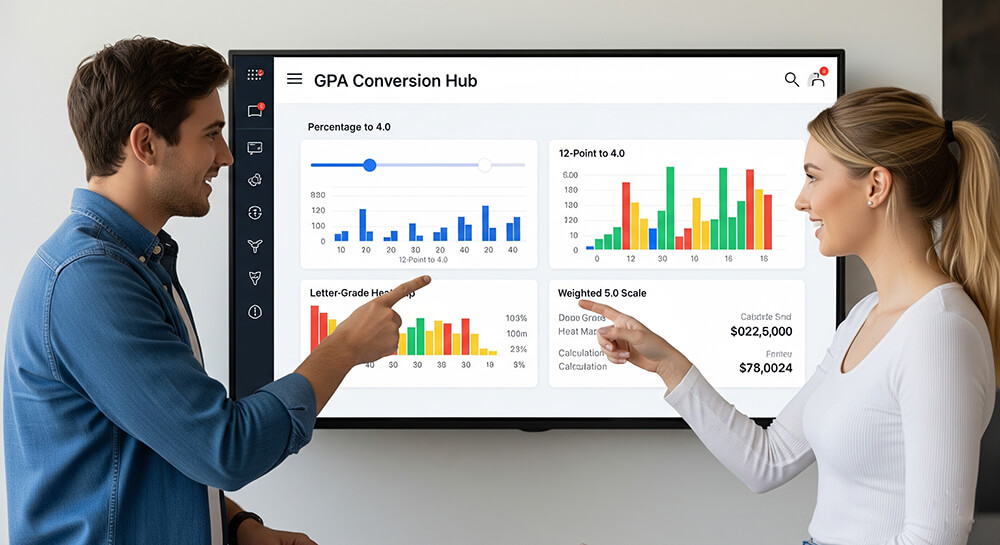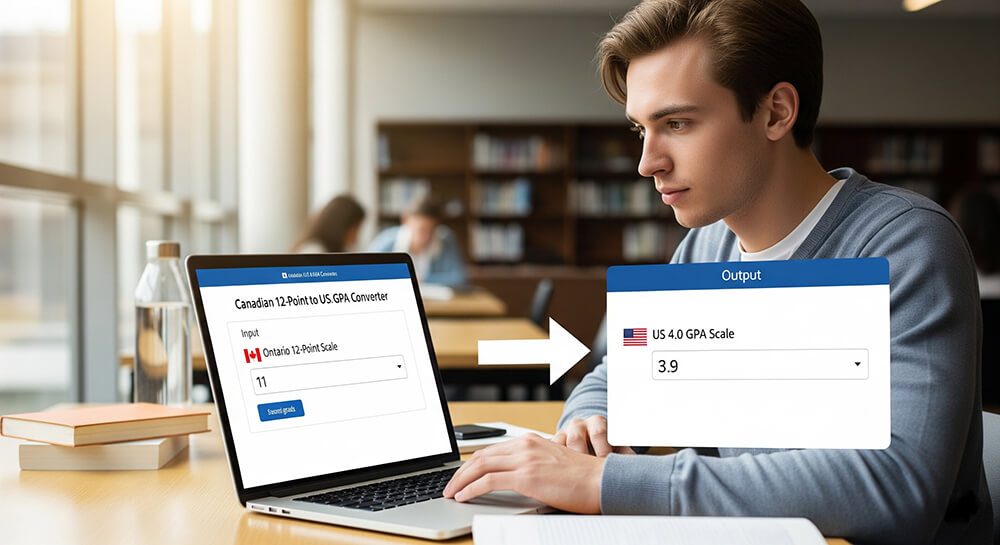Key Takeaways
| Country | Original Scale | Common U.S. 4.0 Conversion Method | Key Consideration |
|---|---|---|---|
| India | 10-Point CGPA | (CGPA / 10) * 4 | A simple and widely used formula. |
| United Kingdom | Degree Classification | First-Class Honours ≈ 3.7-4.0 | Conversion is based on class, not a direct number. |
| Canada (Ontario) | 12-Point Scale | Per-course mapping using official tables. | Avoid averaging before converting each grade. |
| China | 100-Point Scale | Use a professional service like WES. | Direct percentage conversion is often inaccurate. |
| Nigeria | 5-Point GPA | Per-course grade mapping is best. | Simple scaling can result in a misleadingly low GPA. |
Understanding Different GPA Scales
 Grading systems are different around the world. The United States uses a 4.0 scale. Other countries use numbers, letters, or classes. The history of GPA shows how these systems grew. There are many types of GPA scales today. Each one has good and bad points. A good GPA scale comparison can help you see the differences. Understanding the pros and cons of different GPA scales helps you know what your grade means.
Grading systems are different around the world. The United States uses a 4.0 scale. Other countries use numbers, letters, or classes. The history of GPA shows how these systems grew. There are many types of GPA scales today. Each one has good and bad points. A good GPA scale comparison can help you see the differences. Understanding the pros and cons of different GPA scales helps you know what your grade means.
The Basics of GPA Conversion
 GPA conversion changes a grade from one scale to another. This helps schools in the U.S. understand your academic record. You can use GPA conversion charts and tools to help. The process often involves a percentage to 4.0 GPA conversion. You might also need a letter to point GPA conversion guide for specific classes. It is useful to know the difference between quality points vs GPA explained to see how your final score is made.
GPA conversion changes a grade from one scale to another. This helps schools in the U.S. understand your academic record. You can use GPA conversion charts and tools to help. The process often involves a percentage to 4.0 GPA conversion. You might also need a letter to point GPA conversion guide for specific classes. It is useful to know the difference between quality points vs GPA explained to see how your final score is made.
How to Convert Indian 10-Point GPA to US 4.0 Scale
 Many schools in India use a 10-point CGPA. A simple formula helps convert this to a U.S. 4.0 scale. You take the CGPA, divide it by 10, and then multiply by 4. For example, an 8.5 CGPA becomes a 3.4 GPA. This method is very common. Our guide on Indian 10-point GPA to 4.0 scale conversion gives more details. You can also compare the 12-point vs 10-point GPA conversion to see how different scales work.
Many schools in India use a 10-point CGPA. A simple formula helps convert this to a U.S. 4.0 scale. You take the CGPA, divide it by 10, and then multiply by 4. For example, an 8.5 CGPA becomes a 3.4 GPA. This method is very common. Our guide on Indian 10-point GPA to 4.0 scale conversion gives more details. You can also compare the 12-point vs 10-point GPA conversion to see how different scales work.
Converting UK Grades to the US 4.0 GPA System
 The United Kingdom uses a degree classification system. Grades are given as classes, like "First-Class Honours." These classes have U.S. GPA equivalents. A First-Class Honours is like a 3.7 to 4.0 GPA. An Upper Second-Class is like a 3.3 to 3.7 GPA. The exact numbers can change by school. Our guide on the UK class system to 4.0 GPA conversion can provide more clarity. This is especially important if you need a study abroad grades GPA integrator.
The United Kingdom uses a degree classification system. Grades are given as classes, like "First-Class Honours." These classes have U.S. GPA equivalents. A First-Class Honours is like a 3.7 to 4.0 GPA. An Upper Second-Class is like a 3.3 to 3.7 GPA. The exact numbers can change by school. Our guide on the UK class system to 4.0 GPA conversion can provide more clarity. This is especially important if you need a study abroad grades GPA integrator.
Your Guide to Ontario's 12-Point to 4.0 GPA Conversion
 Ontario, Canada uses a 12-point scale. To convert this, you must map each course grade to the 4.0 scale. You should not average your grades first. Official tables show that a 12 is an A+, and an 11 is an A. Our Ontario 12-point to 4.0 GPA conversion guide shows you how. A 12-point to 4-point scale chart is a very helpful tool for this process. This method gives a more accurate result.
Ontario, Canada uses a 12-point scale. To convert this, you must map each course grade to the 4.0 scale. You should not average your grades first. Official tables show that a 12 is an A+, and an 11 is an A. Our Ontario 12-point to 4.0 GPA conversion guide shows you how. A 12-point to 4-point scale chart is a very helpful tool for this process. This method gives a more accurate result.
From China's 100-Point System to a US GPA
 China uses a 100-point grading scale. A direct percentage conversion is not accurate. This is because high grades like 90-100 are very rare in China. Only the top students get them. For a fair conversion, it is best to use a professional service. They can provide context about your school's ranking and grade difficulty. Our China 100-point to 4.0 scale conversion guide offers more insight. You can also explore a 100-point to 5-point conversion for other scale comparisons.
China uses a 100-point grading scale. A direct percentage conversion is not accurate. This is because high grades like 90-100 are very rare in China. Only the top students get them. For a fair conversion, it is best to use a professional service. They can provide context about your school's ranking and grade difficulty. Our China 100-point to 4.0 scale conversion guide offers more insight. You can also explore a 100-point to 5-point conversion for other scale comparisons.
Translating Nigeria's 5-Point GPA to the US 4.0 Scale
 Nigeria's grading system uses a 5-point GPA. An A is worth 5.0 points. A simple formula that scales it down can give a low U.S. GPA. This is due to tough grading standards in Nigeria. The best way is to map each letter grade to its U.S. equivalent. This gives a more accurate picture of your work. Read our guide on Nigeria 5-point to US 4.0 scale conversion for correct methods. The 5.0 GPA scale guide provides more context on how these scales work.
Nigeria's grading system uses a 5-point GPA. An A is worth 5.0 points. A simple formula that scales it down can give a low U.S. GPA. This is due to tough grading standards in Nigeria. The best way is to map each letter grade to its U.S. equivalent. This gives a more accurate picture of your work. Read our guide on Nigeria 5-point to US 4.0 scale conversion for correct methods. The 5.0 GPA scale guide provides more context on how these scales work.
What is GPA Inflation and Deflation?
 GPA inflation means that average grades are rising over time. GPA deflation means that grades are getting lower. This is important for international students. A tough grading system in one country might look like a low GPA in the U.S. It is important to provide context. This helps admission officers understand your grades fairly. You can learn more about GPA inflation vs deflation and how it affects you. A GPA trend graph generator can help visualize your academic progress.
GPA inflation means that average grades are rising over time. GPA deflation means that grades are getting lower. This is important for international students. A tough grading system in one country might look like a low GPA in the U.S. It is important to provide context. This helps admission officers understand your grades fairly. You can learn more about GPA inflation vs deflation and how it affects you. A GPA trend graph generator can help visualize your academic progress.
Weighted vs. Unweighted GPA
 An unweighted GPA is on a 4.0 scale. A weighted GPA can go higher, often to 5.0. This is because it gives extra points for harder classes like AP or Honors. It is important to know the difference between weighted vs unweighted GPA. There are many weighted GPA myths debunked that can clear up confusion. A GPA weighting guide for Honors and AP courses is useful. You can also use a 4.0 vs 5.0 GPA outcome simulator to see potential results.
An unweighted GPA is on a 4.0 scale. A weighted GPA can go higher, often to 5.0. This is because it gives extra points for harder classes like AP or Honors. It is important to know the difference between weighted vs unweighted GPA. There are many weighted GPA myths debunked that can clear up confusion. A GPA weighting guide for Honors and AP courses is useful. You can also use a 4.0 vs 5.0 GPA outcome simulator to see potential results.
Handling Special Cases in GPA Calculation
 Some grades need special attention. A transfer credits GPA integrator helps you combine grades from different schools. It is also key to know how pass-fail grades impact your GPA. Sometimes you might have missing grades. An incomplete grades scenario planner can help you see how they affect your GPA. Good GPA planning for incomplete grades is always a smart move.
Some grades need special attention. A transfer credits GPA integrator helps you combine grades from different schools. It is also key to know how pass-fail grades impact your GPA. Sometimes you might have missing grades. An incomplete grades scenario planner can help you see how they affect your GPA. Good GPA planning for incomplete grades is always a smart move.
Why Accurate GPA Calculation Matters
 A correct GPA is very important for college applications. Small mistakes can change your score. You should avoid common GPA calculation errors. Learning how to calculate GPA correctly is a key skill for any student. The basic GPA formula guide can teach you the main steps. Using a trusted GPA Calculator ensures you get the right number every time.
A correct GPA is very important for college applications. Small mistakes can change your score. You should avoid common GPA calculation errors. Learning how to calculate GPA correctly is a key skill for any student. The basic GPA formula guide can teach you the main steps. Using a trusted GPA Calculator ensures you get the right number every time.
Tools to Help Your GPA Journey
 Many tools can make managing your grades easier. A college GPA calculator is perfect for university students. If you are not in college yet, a high school GPA calculator is what you need. You can track your grades over time with a cumulative GPA calculator. For shorter periods, a semester GPA calculator is very useful. These tools help you stay on top of your academic goals.
Many tools can make managing your grades easier. A college GPA calculator is perfect for university students. If you are not in college yet, a high school GPA calculator is what you need. You can track your grades over time with a cumulative GPA calculator. For shorter periods, a semester GPA calculator is very useful. These tools help you stay on top of your academic goals.
Frequently Asked Questions (FAQ)
1. Can I convert my international GPA myself? Yes, you can get a good estimate using online tools and guides. For simple conversions like the Indian 10-point scale, a formula works well. For complex systems like China's, a professional evaluation service is often better.
2. What if my country's grading system is not listed? You should look for a professional credential evaluation service like WES. They have experience with many different grading systems. You can also check your target university's website for specific international admission guidelines. Our GPA conversion charts and tools cover many systems.
3. Why do some U.S. schools recalculate my GPA? U.S. schools want to compare all applicants fairly. They recalculate GPAs to a standard 4.0 scale. They may also adjust for grade inflation or deflation. This is why understanding weighted vs unweighted GPA is also important.
4. What is the most important thing to remember when converting my GPA? Accuracy is key. Always double-check your work and use reliable sources. Avoid common GPA calculation errors. Providing context about your school's grading system can also help admission officers understand your achievements.
